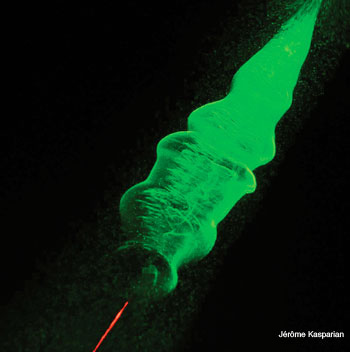 Cloud of water droplets generated in a cloud chamber by laser filaments (in red). The cloud is demonstrated through the scattering of a green laser beam collinear to the first one.
Cloud of water droplets generated in a cloud chamber by laser filaments (in red). The cloud is demonstrated through the scattering of a green laser beam collinear to the first one.
If global warming or stratospheric ozone depletion have taught us anything, it's that humankind can profoundly influence the Earth's climate and environment. So far, our impact on the climate has been largely an unintended consequence of our use of fossil fuels. But what if scientists could alter the weather on purpose? Purposeful local weather modulation—as well as broader attempts to "geo-engineer" climate change—are topics that are being intensively debated within the scientific community and to some extent among the public.
Such a possibility could imply invaluable economical and social consequences. For example, imagine if lasers could be used to stimulate the formation of rain clouds in drought-stricken areas or if lightning studies could help engineers to create safer airplanes or power lines that can withstand lightning strikes. Indeed, rain and lightning, with their far-reaching implications for agriculture and public safety, are the weather-modulation methods that our team and other physicists have focused on most intensively to date.
The advent of ultrashort laser pulses and the discovery of self-guided ionized filaments (by Braun et al. in 1985) opened new perspectives in the domain of weather modulation, especially through Teramobile, an international project initiated jointly by the National Center for Scientific Research in France and the German Research Foundation. Teramobile allows researchers to use the first mobile terawatt laser in the world for atmospheric studies. It enabled us to conduct outdoor experiments of self-guided ionized filaments for real-scale atmospheric testing.
Filamentation of ultrashort laser pulses
Filamentation results from the propagation of ultrashort intense laser pulses in the air. At high incident power (tens of GW to TW) and intensities, the air cannot be considered linear anymore. Rather, it is a nonlinear medium that allows the formation of "self-guided filaments." This process is initiated by Kerr self-focusing. At a high power, the refractive index of the air varies with the incident laser intensity: n(I) = n0 + n2•I, where n2 ≈ 3 x 1019 cm2/W is its nonlinear refractive index, related to nonlinear polarizability.
Since the intensity profile of the beam is generally bell-shaped, the Kerr effect generates a refractive index profile that behaves like a series of lenses with shorter and shorter focal lengths. If the incident power exceeds a so-called critical power (a few GW in air at a wavelength of 800 nm), the Kerr lens overcomes diffraction and the beam energy tends to concentrate on its axis. The local intensity is then sufficient to ionize the air up to an electron density of 1014 to 1015 cm3.
The negative contribution of the free electrons to the refractive index, as well as negative higher-order Kerr indices, balances the self-focusing. The resulting dynamical balance guides light over distances that largely exceed the Rayleigh length, up to hundreds of meters in the atmosphere. These ionized light strings, which are electrically conducting, can be generated at distances up to a few kilometers from the laser source by an adequate choice of the laser parameters, and then directed to any position in the atmosphere by sweeping the beam using a steering mirror.
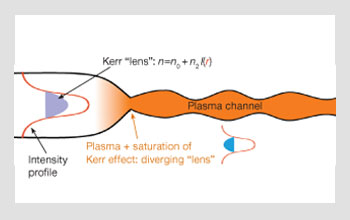 Mechanism of filamentation
Mechanism of filamentation
The Teramobile: A TW laser for field experiments
Atmospheric research using laser filaments requires a laser source that provides high-intensity ultrashort pulses on-site for field campaigns. Outdoor operation constitutes a challenge for ultrashort-pulse lasers because of the limited available space and environmental requirements (e.g., the need to use a clean room and to have a stable temperature and humidity level). We addressed this challenge within the French-German-Swiss Teramobile consortium by involving five groups at the Universities of Lyon (J.-P. Wolf and J. Kasparian), Jena (R. Sauerbrey) and Geneva (J.-P. Wolf), Free University of Berlin (L. Wöste), and the École Polytechnique near Paris (A. Mysyrowicz).
The Teramobile laser is based on the classical CPA (chirped pulse amplification) technique, in which pulses are stretched temporally before being amplified. This is done in order to prevent damage to the amplification chain. After amplification, the pulses are recompressed to their initial duration before being launched into the atmosphere.
What makes Teramobile unique is its compact design (3.5 × 2.2 m), which allowed its integration in a standard 20-foot freight container that offers only 10 m2 laboratory surface for outer dimensions of 6 × 2.4 × 2.6 m. It provides 350 mJ pulses in 70 fs, corresponding to a peak power of 5 TW, centered at a wavelength of 800 nm, at a repetition rate of 10 Hz. Moreover, the compressor is adapted to impose a chirp to the pulses in order to precompensate group-velocity dispersion (GVD) in air.
This feature, combined with a sending telescope with variable focal length, allows us to control both the length and the onset position of the filaments. The Teramobile container includes a comprehensive optics laboratory that has air conditioning, power supplies and a lidar (light detection and ranging) remote sensing system—in addition to the laser itself and thermal and mechanical protections from outside perturbations.
Filament-assisted water condensation in the atmosphere
A century ago, Lord C.T.R. Wilson observed the effect of charges on the condensation of vapors in saturated conditions. Wilson noted the condensation of droplets along the trajectory of cosmic rays in a so-called "cloud chamber." In this experiment, the charges initiate condensation nuclei, which will further grow in the saturated atmosphere of the condensation chamber. Laser filaments can be expected to have an even stronger effect, since they produce at least 106 times more charges than cosmic rays do. They are therefore excellent candidates to assist in the condensation of water droplets in saturated atmospheres.
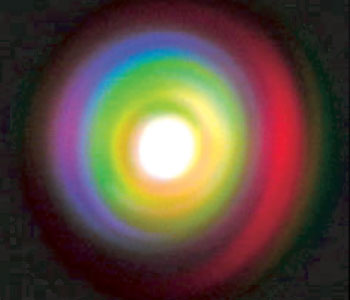 Filamenting beam on a screen: Colored conical emission is clearly visible around the filament (white center).
Filamenting beam on a screen: Colored conical emission is clearly visible around the filament (white center).
Indeed, we observed that introducing filaments in a cloud chamber saturated with water vapor results in the spectacular condensation of a cloud, which is very well visible with the bare eye. Surprisingly, the same effect can also be seen in sub-saturated conditions. Such unexpected droplet stability and growth, in spite of relative humidity that is insufficient to balance the surface tension, is the sign of a specific mechanism at play in the context of laser-induced water condensation. We expect that this mechanism implies both photochemistry initiated by the high intensity of the incident laser pulses and oxidative chemistry due to the concentration of electrons up to 1015 cm-3.
These processes promote the formation of O3 as well as •OH radicals, which will in turn generate hygroscopic H2SO4 and HNO3 condensation nuclei from the SO2 and nitrogen of the atmosphere, respectively. These hygroscopic particles then grow, forming cloud condensation nuclei, which are chemically stabilized, even in sub-saturated atmospheres. They can therefore further expand into the droplets that we have observed experimentally. The laser-generated charges can also contribute to the formation of larger droplets by promoting the coalescence of the smaller particles bearing opposite charges.
These mechanisms, which trigger laser-induced nucleation in sub-saturated atmospheres, are not restricted to laboratory experiments. We have also observed condensation in the real atmosphere. For that purpose, we launched the Teramobile beam vertically into the atmosphere over the city of Berlin, Germany. We used a second, low-power laser beam as a probe overlapping with the filaments and detected its backscattering in a lidar configuration. Although the atmosphere was sub-saturated (90-93 percent relative humidity), switching the Teramobile laser on increased the backscattering from the filaments by a factor of 20. This effect can be unambiguously attributed to the formation of new particles and demonstrates the effect of the laser.
 Teramobile, the mobile femtosecond terawatt laser: L1-L7 are laser elements; S = sending telescope; C = power supplies and temperature control; D = Lidar detection system.
Teramobile, the mobile femtosecond terawatt laser: L1-L7 are laser elements; S = sending telescope; C = power supplies and temperature control; D = Lidar detection system.
Lightning control
Filaments are not the only source of electrification at play in the clouds. Due to internal air mass movements (especially convection), particles such as water droplets or ice crystals undergo collisions at speeds up to 20 m/s, in which they get charged. The segregation of different particle types within separate clouds regions results in overall electric fields across the cloud. The influence of these charges also initiates fields up to 10 or 15 kV/m at ground level and 50 kV/m several hundreds of meters above. Such huge fields are at the root of lightning—one of the most spectacular and potentially destructive atmospheric phenomena known to humans.
A lightning discharge begins with the elongation of cloud water droplets into ellipsoids, which enhances the electric field at their ends, initiating corona discharges. These discharges connect and form an ionized channel, or leader, which proceeds by steps of several tens of meters, separated by idle times of 50 to 100 μs.
During its propagation, the leader can split into several branches. When one reaches close to the ground, an ascending leader is generated from a tree, building, mountain or other elevated point and progresses towards the descending leader. When they connect, a current up to several hundreds of kilo-amperes flows from the ground to the cloud: The so-called return stroke, which lasts from a few tenths of a second to a few seconds, constitutes the visible and audible part of the lightning strike.
Since stepped leaders are typically 10 m long, it would not be realistic to fully reproduce the mechanism of lightning in the laboratory. Even field experiments are challenging, given the random character of lightning and the need to accumulate reproducible data.
Researchers have developed a technique to trigger lightning on demand by launching a rocket that pulls a thin metallic wire toward thunderclouds. The rocket and its wire act like a lightning rod, which triggers the lightning strike and guides it to the ground. A more realistic effect can be obtained by limiting the metallic section of the wire to a few tens of meters, so that the discharge hitting the ground is very close to the natural one.
However, the number of rockets available during a thunderstorm is limited by the launch pad, which can host 5 to 10 rockets in typical facilities and cannot be refilled before the end of the thunderstorm. Furthermore, the success rate depends strongly on the instant when the rocket is launched. A continuously operating technique to trigger lightning would therefore be highly desirable. Lasers have very early been identified as candidates for this purpose. The first tests were performed almost as soon as high-power lasers were available in the 1960s.
These experiments, which used "long" laser pulses of several nanoseconds or more, were not successful. The leading edge of the pulse ionizes the air and accelerates the free electrons, resulting in avalanche ionization and finally a dense plasma that absorbs the trailing edge of the pulse. As a consequence, a large part of the pulse energy is lost, so that the generated plasma column is limited to a few meters in length.
In contrast, ultrashort (sub-100 fs) laser pulses are too short to initiate electron avalanches. The electron density therefore stays lower than in the case of "long" pulses, and the plasma remains transparent to the laser pulse. As a consequence, ionized self-guided filaments can exceed 100 m in length.
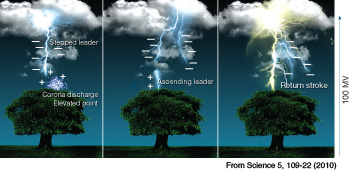 The mechanism of lightning initiation: Left to right: Formation of a stepped leader; initiation of an ascending leader; return stroke.
The mechanism of lightning initiation: Left to right: Formation of a stepped leader; initiation of an ascending leader; return stroke.
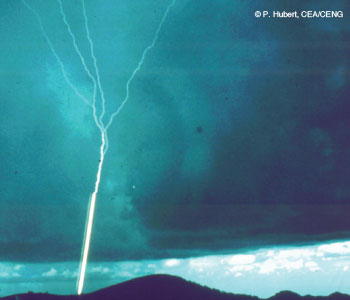 Lightning strike guided by a wire-pulling rocket at Langmuir Laboratory (New Mexico Tech, N.M.)
Lightning strike guided by a wire-pulling rocket at Langmuir Laboratory (New Mexico Tech, N.M.)
Using the Teramobile laser system, we first demonstrated their capability to trigger high-voltage discharges. By connecting two electrodes that were several meters apart, the laser filaments reduced the breakdown voltage by 30 percent, triggering the discharge in conditions that would not have allowed them without the laser. Furthermore, these triggered discharges are guided along the laser filaments rather than following the erratic path typical of a classical electric discharge.
Getting through stormy weather
Besides the fact that the mechanism of meter-scale discharges in the laboratory is not fully representative of real lightning, two conditions are required to extend the above laboratory results on megavolt discharges to the real atmosphere.
First, laser filaments must propagate through the turbulent medium of the thundercloud and even through rain. This is made possible because the filamentation process is particularly robust. Filaments do not bear the whole energy of the laser beam. They are surrounded by a "photon bath" that regenerates them if they have been blocked by an obscurant such as a water droplet. We observed that this mechanism allows filamentation to be transmitted even through dense clouds.
Similarly, atmospheric turbulence does not block filamentation because refractive index gradients due to atmospheric inhomogeneities are too weak to block the dynamic balance at play in the filament. Furthermore, filaments transmitted through perturbed atmospheres retain their main properties. In particular, we have shown that they can still trigger high-voltage discharges under an artificial heavy rain.
Second, the lifetime of the plasma generated by the laser lies in the microsecond range. At a speed close to 1 m/μs, the discharge can only propagate over a few meters before the plasma vanishes. This propagation distance defines the useful length of the filament. A second laser could extend it by keeping the plasma active: We significantly increased the rate of discharge triggering by launching a nanosecond YAG laser pulse of moderate energy (400 mJ) after the Teramobile pulse and collinear to it.
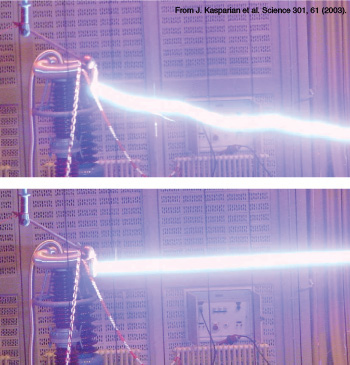 Free (top) and guided (bottom) high-voltage discharges. The high-voltage electrode (spherical, on the left) represents the cloud, while the plane electrode (right) is grounded.
Free (top) and guided (bottom) high-voltage discharges. The high-voltage electrode (spherical, on the left) represents the cloud, while the plane electrode (right) is grounded.
These encouraging results apparently stem from a retroaction loop between the reduced attachment efficiency of the electrons at high temperature on one side, and the increased Joule effect in the ionized filament inside the electric field between the electrodes on the other side. Substantial modelling work is in progress to better understand the mechanisms at play and to optimize the process.
Based on our successful results at the laboratory scale, we organized a field campaign during the summer of 2004 at the Langmuir Laboratory of the New Mexico Tech, on South Baldy peak (3,200 m altitude). This permanent station dedicated to lightning studies is equipped with a network of radiofrequency antenna capable of locating the electric activity of clouds with nanosecond-precision date stamping.
The network detected micro-discharges synchronized with the pulses from the Teramobile laser, showing that the conducting filaments generated by the laser pointed toward the thundercloud have behaved like a metallic tip directed towards a loaded electrode: They have initiated corona discharges at their tip. Our result provides observable evidence that allows us to optimize the laser parameters in future field campaigns. It therefore constitutes a significant step toward the control of lightning by lasers.
This technique would not only allow us to trigger lightning on demand so that we could characterize it, but it may also ultimately allow us to protect critical facilities such as airports or power plants against the so-called indirect effects of lightning—in other words, the electromagnetic perturbations induced by the transient current conducted to the ground by the earthing cable of the lightning rod. These effects could be avoided by guiding lightning away from the facility using a laser that would itself be protected by a Faraday cage or a grounded metallic steering mirror.
In conclusion, the recent progress of the ultrashort-pulse laser technology could greatly facilitate the practical applications of these results and techniques. Although lighting control or triggering rain on a real scale remain science fiction for now, the spectacular results that the Teramobile team has achieved, both in the laboratory and in the atmosphere, have brought these dreams of humankind closer to reality.
and Jean-Pierre Wolf are with Teramobile, GAP Biophotonics in Geneva, Switzerland. is with Teramobile, Institut für Experimentalphysik, Freie Universität Berlin, Arnimallee in Berlin, Germany.
References and Resources
>> Teramobile
>> J. Kasparian et al. "White-light filaments for atmospheric analysis," Science 301, 61 (2003).
>> J. Kasparian et al. "Electric events synchronized with laser filaments in thunderclouds," Opt. Express 16, 5757 (2008).
>> J. Kasparian and J.-P. Wolf. "Physics and applications of atmospheric nonlinear optics and filamentation," Opt. Express 16, 466 (2008).
>> P. Rohwetter et al. "Laser-induced water condensation in air," Nature Photon. 4, 451 (2010).
